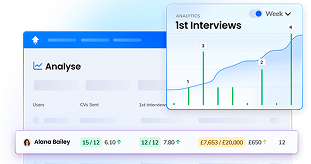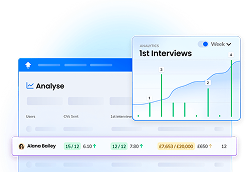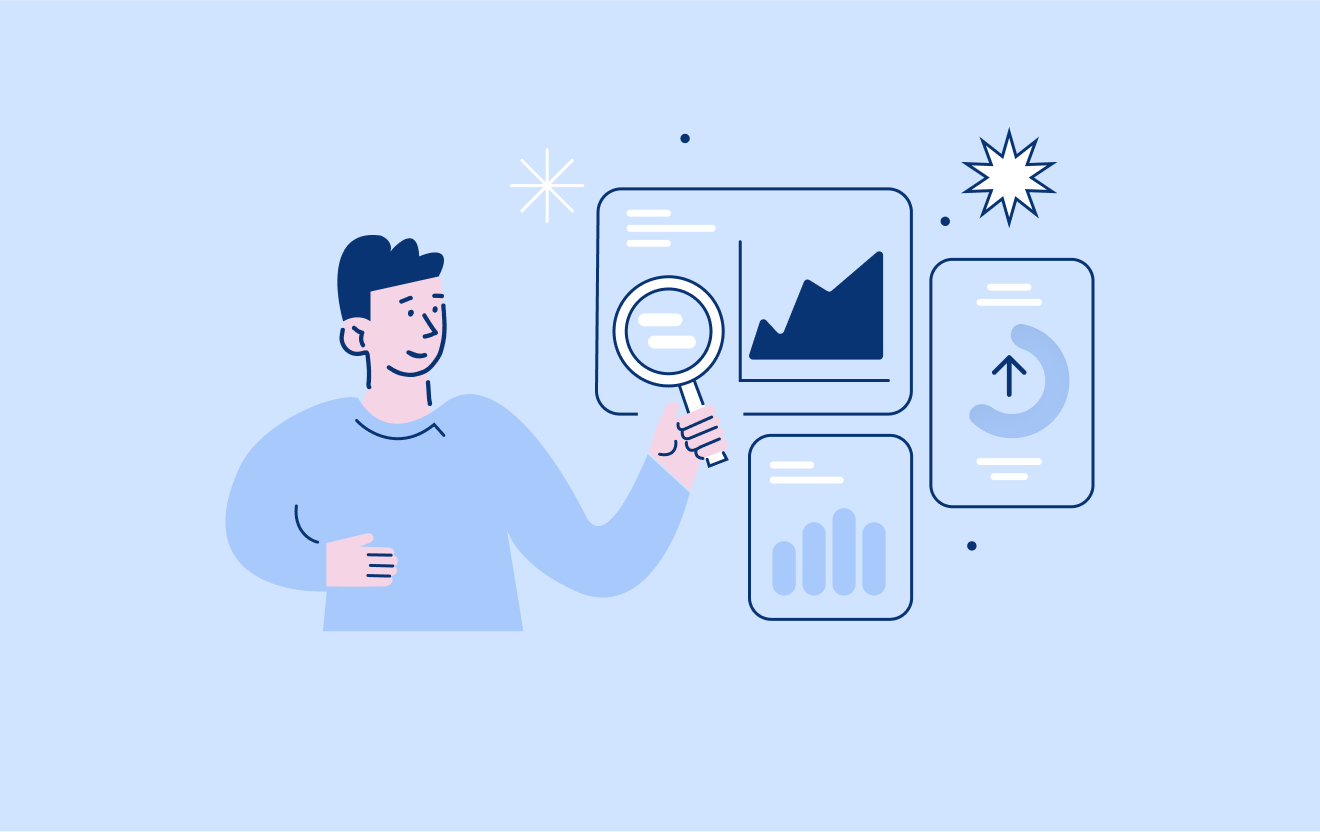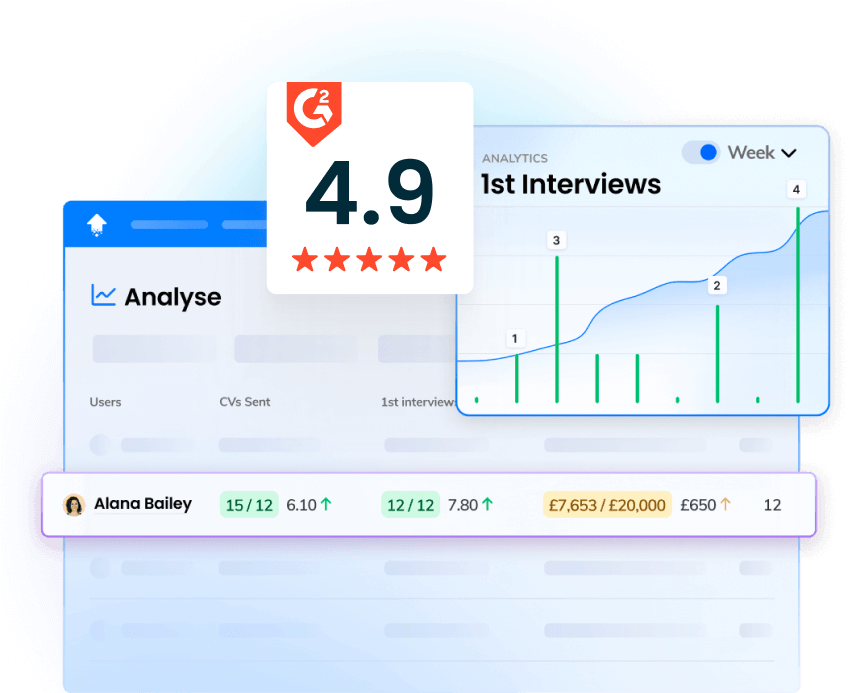A structured recruiting workflow is an absolute game-changer for hiring success and business efficiency.
Standardise, automate and continually optimise your workflows to achieve a more organised and consistent recruitment process that helps teams find the right talent faster.
With clear steps — like job posting, screening, interviewing, and onboarding — everything runs smoother, reducing mistakes, cutting time-to-hire, and allowing you to focus on making great hires.
Plus, it makes life easier for both recruiters and candidates, creating a better experience.
And in the long run, a solid recruiter workflow means better employees, lower turnover, and a more successful company.
So, what exactly is a recruiting workflow, and how can you achieve these benefits?
Read on to find out.
What Is a Recruiting Workflow?
Here’s a simple definition.
A workflow is a step-by-step process that guides hiring from job posting to onboarding.
It includes recruitment milestones like:
➡️ Screening applications
➡️ Conducting interviews
➡️ Making offers
A well-structured recruitment process workflow eliminates inefficiencies and inconsistencies and reduces hiring delays, translating to an enhanced candidate experience and happier clients.
When it comes to the bottom line, you can expect to see reduced time-to-hire and a higher revenue-per-recruiter.
Types Of Workflows
When leading a recruitment agency, there are several different workflows to take into account.
Here are the three major types of workflow to focus on.
Full-Cycle Recruitment Workflow
This covers the entire hiring process from start to finish.
It includes job posting, sourcing candidates, screening applications, interviewing, making job offers, and onboarding new hires.
Not every agency’s full-cycle recruitment workflow process will look the same, with adjustments made for specific goals, tools or circumstances.
However, it will probably go a little something like this:
- The recruiter works with the hiring manager to create a detailed job description and post the role across relevant platforms.
- The recruiter sources and attracts candidates, reviewing resumes, conducting initial screenings, and shortlisting potential applicants.
- The recruiter schedules interviews, which may involve multiple rounds, including phone, in-person, or technical interviews. Throughout this stage, they assess candidates’ skills, experience, and cultural fit.
- After interviews, the recruiter makes an offer to the top candidate and negotiates terms as needed.
- Once the candidate accepts, the recruiter handles the onboarding process, ensuring a seamless transition into the company.
By managing every step, from sourcing to integration, the full-cycle recruiter enhances efficiency, reduces time-to-hire, and ensures the company hires the best-fit talent for the role.
Internal Hiring Workflow
For recruitment agencies, this generally means recruiting recruiters.
This workflow typically involves several stages: defining the role, sourcing candidates through job boards or referrals, screening resumes, and conducting initial interviews.
The process includes skills assessments, behavioural interviews, and cultural fit evaluations.
Once a candidate is selected, the agency extends an offer, followed by onboarding and training.
The workflow ensures that recruiters are well-equipped to effectively manage client needs and attract top talent.
Specialised Workflows
If your agency specialises in any area — for example, contract recruiting, RPO, or volume hiring — you must make space for a specialised workflow.
Key Stages of a High-Performance Recruiting Workflow
Let’s take a closer look at the key stages of a high-performance recruitment workflow.
Step 1 – Job Intake & Client Briefing
The job intake and client briefing stage is a crucial starting point in a high-performance recruiting workflow.
During this phase, the recruiter collaborates closely with the client (hiring manager or HR team) to fully understand the job requirements, company culture, and specific expectations for the role.
The goal is to ensure alignment between what the client is looking for and what is feasible in the talent market.
Key actions include:
- Aligning with the client’s hiring expectations: It’s vital to sit down with your client to discuss the ideal candidate profile, including essential skills, experience, and cultural fit. During this meeting, clarify any deal-breakers and non-negotiables, such as certifications or specific technical knowledge.
- Defining KPIs: Use OneUp recruitment analytics for historical benchmarking, establish your SMART goals, and decide which recruitment metrics to track. For example:
- Time-to-fill: The average number of days from posting the job to making an offer.
- ➡️ Cost-per-hire: The total cost involved in hiring, including advertising, recruiter fees, and interview expenses.
- ➡️Quality of hire: How well the new hire performs after a set period, often linked to performance metrics or retention rates.
- Understanding urgency: Identify whether the role is urgent or has room for flexibility, as this will shape the recruitment strategy and timeline.
- Setting expectations for candidate experience: Ensure the client understands how important a positive, smooth candidate experience is, especially in competitive job markets.
- Discussing the recruitment process: Agree on the process for interviews, feedback, and final decision-making. Set out which tools your agency uses — for example, your applicant tracking system (ATS) or CRM — and which, if any, the hiring manager will gain access to.
Step 2 – Candidate Sourcing Strategy
Once you’ve hammered out the details, it’s time to get sourcing.
Fortunately, in 2025, sourcing is nowhere near as time-consuming as it once was.
At the same time, finding the best matches for roles is easier than ever.
And it’s all thanks to AI and workflow automation for recruiters.
Indeed, automation and AI-powered tools streamline recruitment sourcing by quickly identifying, screening, and engaging potential candidates.
Here’s how:
🤖 AI-powered tools analyse job descriptions, scan databases, and match resumes to find the best-fit candidates.
🤖 Automated chatbots engage with applicants, answer questions, and schedule interviews, reducing recruiter workload.
🤖 Machine learning algorithms assess candidate suitability based on skills, experience, and even cultural fit.
🤖 AI-driven recruitment workflows help eliminate bias by focusing on objective criteria.
🤖 Predictive analytics identify sourcing trends and improve hiring strategies.
Of course, it’s vital that recruiters are hands-on during the sourcing process - even if AI and automation are doing the bulk of the admin tasks.
During this phase of recruitment, be sure to:
➡️ Optimise Boolean search: Master Boolean search techniques to refine keyword-based candidate searches across job boards and databases.
➡️ Tap into passive talent: Reach out to professionals who aren’t actively job hunting but might be open to new opportunities.
➡️ Personalise outreach: Craft tailored messages that highlight a candidate’s specific skills and potential fit for the role.
➡️ Build and nurture talent pipelines: Maintain relationships with strong candidates for future opportunities through regular engagement.
➡️ Use niche job boards: Narrow your searches and discover untapped talent pools by using niche job boards.
➡️ Launch a referral scheme: Employee referrals often lead to the highest quality candidates.
Step 3 – Screening & Shortlisting
It’s time to identify the most suitable candidates for further evaluation.
This is generally a five-stage process that looks something like this ⬇️
- CV screening
- Pre-screening assessments
- Shortlisting candidates
- Initial interviews
- In-depth interviews
AI-powered tools and automation are, once again, going to be your best friend during the screening and shortlisting stage.
Here’s how you can use this tech here:
🤖 Resume parsing and matching – AI scans and analyses CVs, extracting key skills and qualifications to match them with job descriptions.
🤖 Automated pre-screening questions – Chatbots or AI-driven assessments filter out unqualified candidates by asking predefined questions.
🤖 One-way interview tools - These tools conduct screening video interviews with candidates without recruiter intervention. Simply pre-set your questions and then review the video afterwards.
🤖 AI-powered candidate scoring – Machine learning ranks applicants based on experience, skills, and cultural fit, reducing manual effort.
🤖 Video interview analysis – AI assesses recorded video interviews for speech patterns, sentiment, and suitability.
🤖 Data insights - Recruitment analytics tools like OneUp automatically present the real-time insights you need to refine talent quality.
🤖 Bias reduction – AI ensures fairer screening by focusing on skills and qualifications rather than unconscious biases.
Step 4 – Interview & Selection Process
While interviews and selection are very much a human-led part of the recruitment process, AI-powered tools can still make this stage more efficient.
🤖 Automated interview scheduling – AI chatbots or scheduling tools coordinate interview times, reducing back-and-forth communication.
🤖 AI-powered video interviews – AI analyses video interviews for tone, speech patterns, and facial expressions to assess candidate suitability.
🤖 Real-time transcription and analysis – AI tools transcribe interviews, highlight key responses, and compare them against job requirements.
🤖 Bias reduction and data-driven insights – AI ensures consistency in evaluations, helping recruiters make fair, data-backed hiring decisions.
Step 5 – Offer, Negotiation & Placement
Again, while this stage may require plenty of (human) discussions, AI and automation tools can make the process much less time-consuming.
Here’s how:
🤖 Automated offer generation – AI can create personalised offer letters based on company policies, market trends, and candidate expectations.
🤖 Automated contract generation - AI can compose personalised contracts and send them to the successful candidate.
🤖 Salary benchmarking and insights – AI analyses industry data to recommend competitive salary packages and benefits.
🤖 Chatbot-assisted negotiations – AI chatbots facilitate real-time discussions, answering FAQs about compensation, benefits, and job terms.
🤖 Predictive analytics – AI predicts offer acceptance likelihood based on past data, helping recruiters adjust offers proactively.
🤖 Onboarding automation – AI streamlines background checks, document collection, and initial training, ensuring a smooth transition.
Exemplary Recruitment Workflows
The workflow above would typically be used by a standard full-cycle agency handling permanent placements.
Let’s look at how your recruitment workflow might change if you’re working in a high-volume agency or contract recruiting.
Example 1: High-Volume Recruitment Workflow
Agencies working on large-scale hiring projects will have a slightly different workflow.
Recruiters don’t necessarily have the time to look as closely at each individual candidate as those in headhunting roles would, for example.
This workflow incorporates as much AI as possible in order to help recruiters manage the high volume of applicants and successful candidates.
Take a look ⬇️
- Job posting and sourcing – AI-driven tools distribute job ads across multiple platforms and source candidates from databases.
- Automated screening – AI scans resumes, applies keyword matching and conducts chatbot pre-screening.
- Shortlisting and assessments – AI ranks candidates, and online tests evaluate skills and job fit.
- Automated interview scheduling – Scheduling tools coordinate interviews without manual effort.
- Interviews and evaluations – AI analyses responses, and recruiters assess top candidates.
- Offer and onboarding – AI automates offer letters, background checks, and onboarding processes for a seamless experience.
Example 2: Contract Recruitment Workflow
Contract recruitment workflows are typically fast-paced for short-term, high-demand roles.
Designed to ensure fast and efficient hiring for temporary or project-based roles, these workflows don’t focus heavily on the personalities or backgrounds of individual candidates, with more emphasis on whether they can get the job done.
Here’s an example of how this might look:
- Client requirements and job posting – Gather job details, budget, and duration; post roles on relevant platforms.
- Candidate sourcing and screening – Use AI tools and databases to find skilled contractors; screen resumes for experience and availability.
- Shortlisting and interviews – Conduct quick assessments and interviews to verify expertise.
- Offer and contract negotiation – Automate offer letters, negotiate terms, and finalise contracts.
- Onboarding and compliance – Verify legal documentation, ensure compliance, and facilitate a smooth onboarding process.
- Assignment management – Monitor performance, handle renewals, and manage offboarding when the contract ends.
Micro Recruitment Workflows – Small Automations With Big Impact
Implementing AI might sound like a big deal, but in reality, it’s no different from bringing any software on board.
The worst thing you can do is avoid investing in AI tools because it seems too daunting.
Instead, just simply start small and get the ball rolling asap.
To help you do just that, here are some low-effort, high-impact automations you can implement by this time next week.
🤖 Automated candidate outreach: Auto-send emails, texts, and direct messages to passive candidates with tools like Zapier and Lemlist.
🤖 Automate interview reminders: Reduce no-shows at interviews with text and email automation, using tools such as Calendly, Twilio and AI chatbots.
🤖 Automate offer letter generation: Auto-generate and e-sign contracts in seconds with tools like HelloSign and DocuSign.
Common Recruiting Workflow Mistakes & How to Avoid Them
❌ Poor job descriptions – Vague or unclear job postings attract unqualified candidates.
✅ Solution: Clearly define responsibilities, required skills, and company culture to attract the right talent.
❌ Over-reliance on manual processes - Failure to embrace recruitment automation software and AI significantly slows workflows and puts you behind your competition.
✅ Solution: Investigate your workflow to identify which stages would benefit most from AI and automation, and then implement these tools.
❌ Lack of candidate engagement – Poor communication leads to dropouts and a negative experience.
✅ Solution: Automate updates and personalise outreach to keep candidates engaged.
❌ Ignoring passive candidates – Relying only on active applicants limits hiring potential.
✅ Solution: Use sourcing tools to proactively reach out to passive talent.
❌ Slow decision-making – Delays in shortlisting and offers result in lost candidates.
✅ Solution: Streamline approvals, automate workflows, and set clear hiring timelines.
❌ Failing to track top recruiting KPIs and recruitment performance metrics - If you don’t have the capabilities to make data-driven decisions in 2025, you’re going to fall behind the competition.
✅ Solution: Arming yourself with an outstanding recruitment analytics platform like OneUp empowers you to make data-driven decisions and continuously optimise your processes for success.
❌ Not adapting workflows based on data insights - Equipping your team with accurate data insights won’t make a difference unless you take action based on your findings.
✅ Solution: Set up a process for regularly reviewing and taking action on the latest data insights.
Conclusion & Key Takeaways
Implementing a high-performance recruiting workflow is not a quick or easy process — but in these competitive times, it is absolutely crucial to your agency’s success.
To recap, for full-service agencies recruiting permanent staff, your recruitment workflow should look something like this ⬇️
Step 1: Job intake and client briefing
Step 2: Candidate sourcing strategy
Step 3: Screening and shortlisting
Step 4: Interview and selection process
Step 5: Offer, negotiation and placement
Remember — optimising each step for both AI/automation and data insights is vital.
If you’re looking for recruiting analytics software that combines data insights with recruitment automation, check out OneUp.
With custom dashboards and automated real-time reports, OneUp gives recruiters the information they need to make data-driven decisions.
It automatically pulls data from across your tech stack to ensure that an update on progress against recruiter performance or other goals is just one click away.
🚀Want to make more accurate, data-driven decisions and level up your recruitment agency? Book your OneUp demo here today.




















